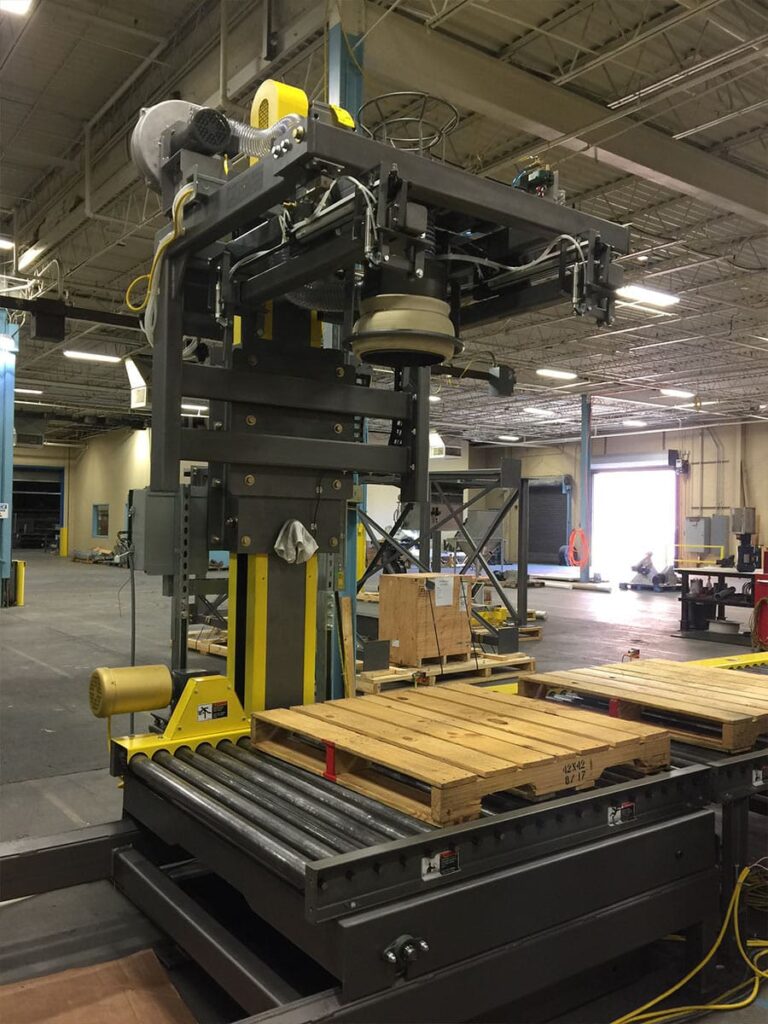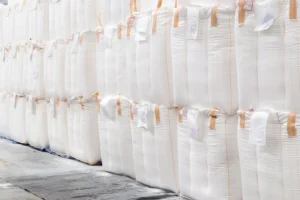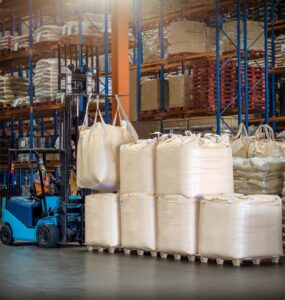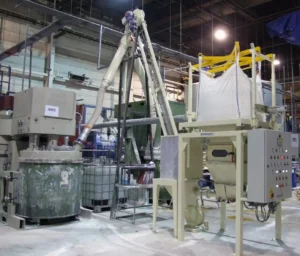Whether in small businesses or large manufacturing settings, the benefits of bulk bag filler automation are clear. This technology reshapes packaging and material handling across industries, enhances productivity, reduces labor costs, and streamlines operations.
Bulk Bag Filler Automation Benefits
Increasingly, manufacturers are recognizing the advantages of transporting dry bulk ingredients in flexible intermediate bulk containers (FIBCs or bulk bags). The savings in ingredient costs, material handling, warehousing, and transportation requirements can be substantial.
The Importance of Proper Bulk Bag Filling Equipment
These benefits can only be realized when appropriate bulk bag-filling equipment is applied. Properly designed bulk bag fillers deliver a dense, stable package that can be safely and easily stored, transported, and discharged. The savings that properly filled bulk bags deliver can be augmented by automating the filling system to increase filled bag output.
Automating Bulk Bag Filling Systems
Depending on the application, automated bulk bag filling systems can range from a single, microprocessor-controlled machine filling ten bulk bags per hour to multiple units, each outputting 20 bags per hour, to a multi-station filler producing 70 one-ton bags per hour.
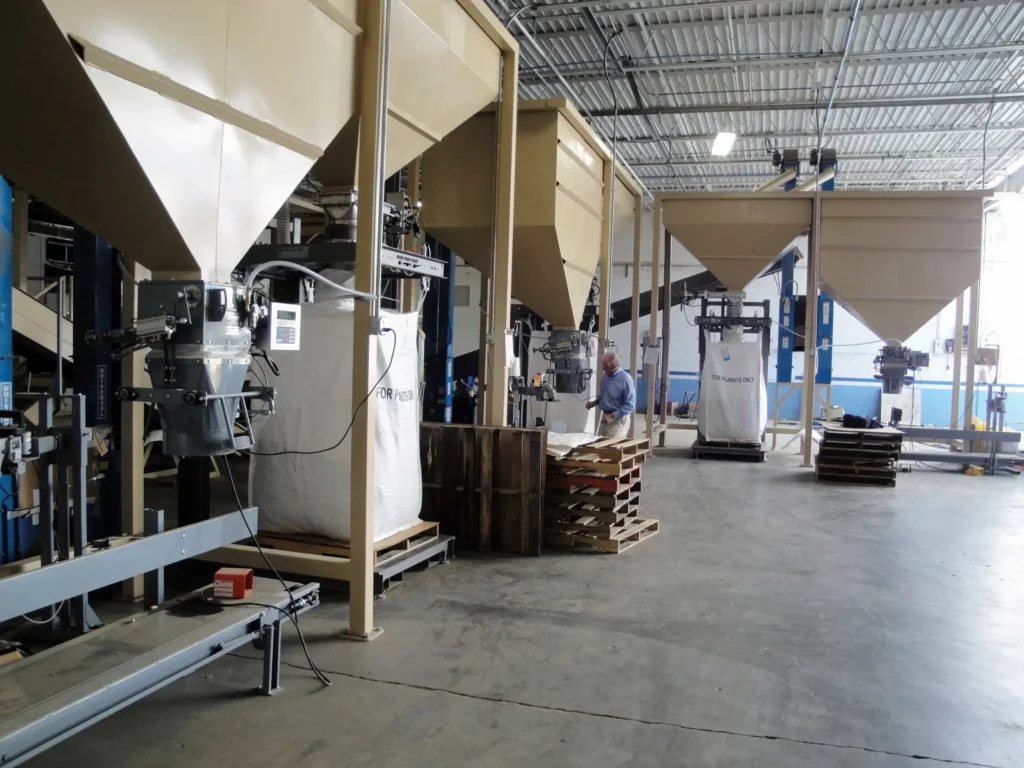
Filling Bulk Bags Properly
Any benefits from filling bulk bags in greater volume must be qualified by careful analysis of the quality of the resulting filled bag. For example, if you use one bulk bag filler to fill 20 bags per hour without proper densification and then have to store them unstacked or in racks because the bags are leaning and unstable – you will be paying a premium for storage space, transportation, and labor.
Optimizing for Efficiency and Stability
It is most effective to specify a bulk bag filler that maximizes the ingredients in the bag and produces a straight and stable package. Once you can stack, convey, and transport the filled bags efficiently, you can investigate automation techniques to best match your production rates and secure the highest efficiency for your operation. Look for a bulk bag filler designed to hang fill the bag to produce straight sides and to fill the corners of the bag first to maximize stability. A bulk bag filler should also densify and compact the ingredients and weigh the bulk bag accurately and reliably.
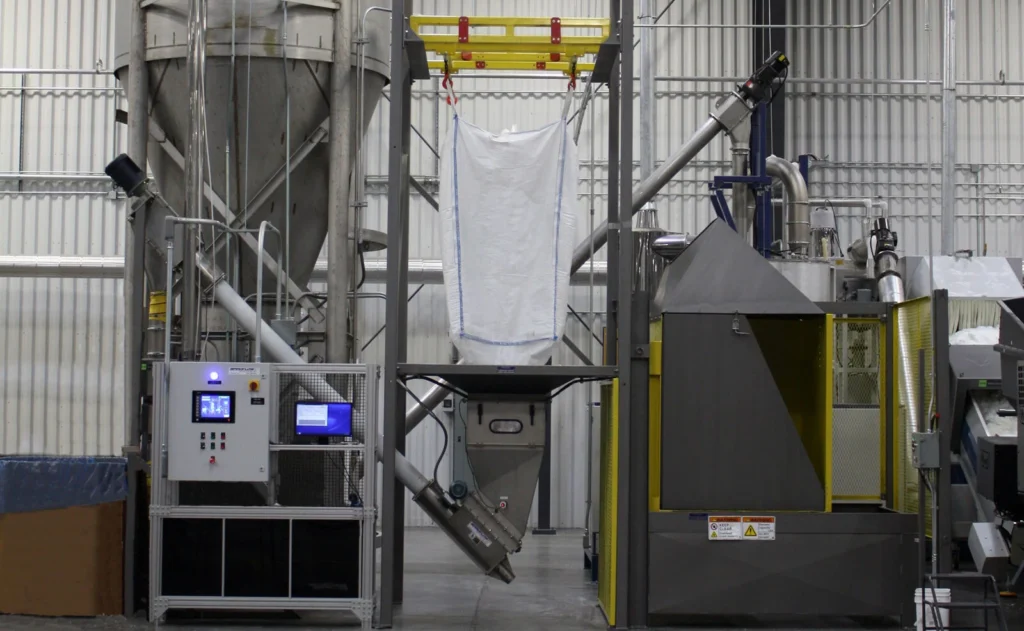
Bulk Bag Filler Automation Opportunities
Filling a bulk bag comprises three main operational steps – rigging the bag, filling the bag, and taking the filled bag away from the machine. Automating a bulk bag-filling operation can be approached on four levels:
- Adding an automatic control system to a manual machine,
- Automating the removal of the filled bag and placing it on a pallet (if necessary)
- Pre-weighing the ingredient to reduce the overhead time associated with bag rigging and ingredient feeding,
- Providing a multi-station machine to simultaneously perform the three operational steps.
A typical filling operation requires the rigged bag or liner to be inflated, the weight of the machine or part of the machine to be tared out, the fill to be initiated, the densification and compaction to be cycled, and the fill rate to be slowed by some method in order to successfully achieve the target weight.
Enhancing Productivity With Microprocessor-Based Controllers
A microprocessor-based controller can automate almost all of these steps. Once the operator has rigged the bag and inflated it, taring the weighing system initiates the automated fill cycle, whereby the controller takes over the sequencing of starting and stopping ingredient flow into the bag, densification, and weighting. A typical system of this sort can achieve an output of up to 10 bags per hour, depending on the maximum flow rate of ingredients into the bag. A manual system may be only capable of six to eight bags per hour.
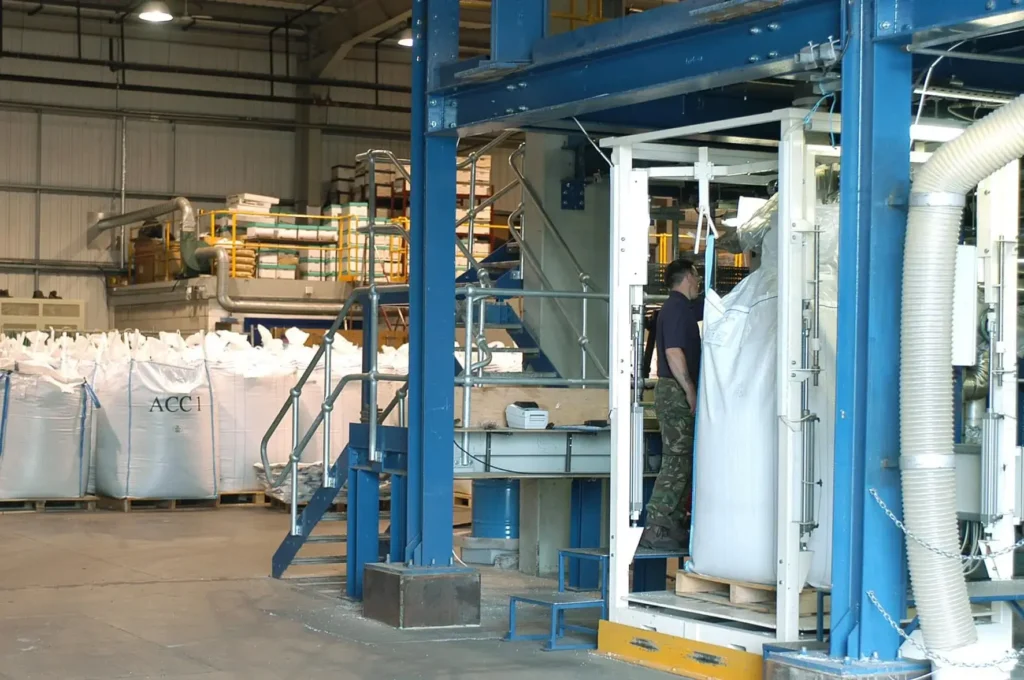
Automatic Bulk Bag Removal
Typically, the filled bulk bag is removed from the filling machine by a forklift truck. Providing a means of quickly freeing up the space inside the filling machine to rig a second bag once the first is full can increase the output rate and reduce the need for a dedicated forklift truck. Roller or chain conveyors can be positioned in the filler to remove the filled bag automatically. Motorized or gravity conveyors can be added to allow filled bag accumulation for later transport by forklift truck.
Streamlining Operations with Pallet and Slip Sheet Dispensers
Pallet and slip sheet dispensers can be added to the system, along with additional motorized conveyors, to automatically position a pallet in the machine or to pick up the filled bag on a pallet. This eliminates the need for an operator to manually place the pallet in the machine.
Automatic bulk bag removal can increase the output of a stand-alone microprocessor-controlled bulk bag filler to 12 to 14 bags per hour. Filled bags with specially designed lifting loops can be handled easily with fork trucks. This may further increase system output as pallets need not be accommodated.
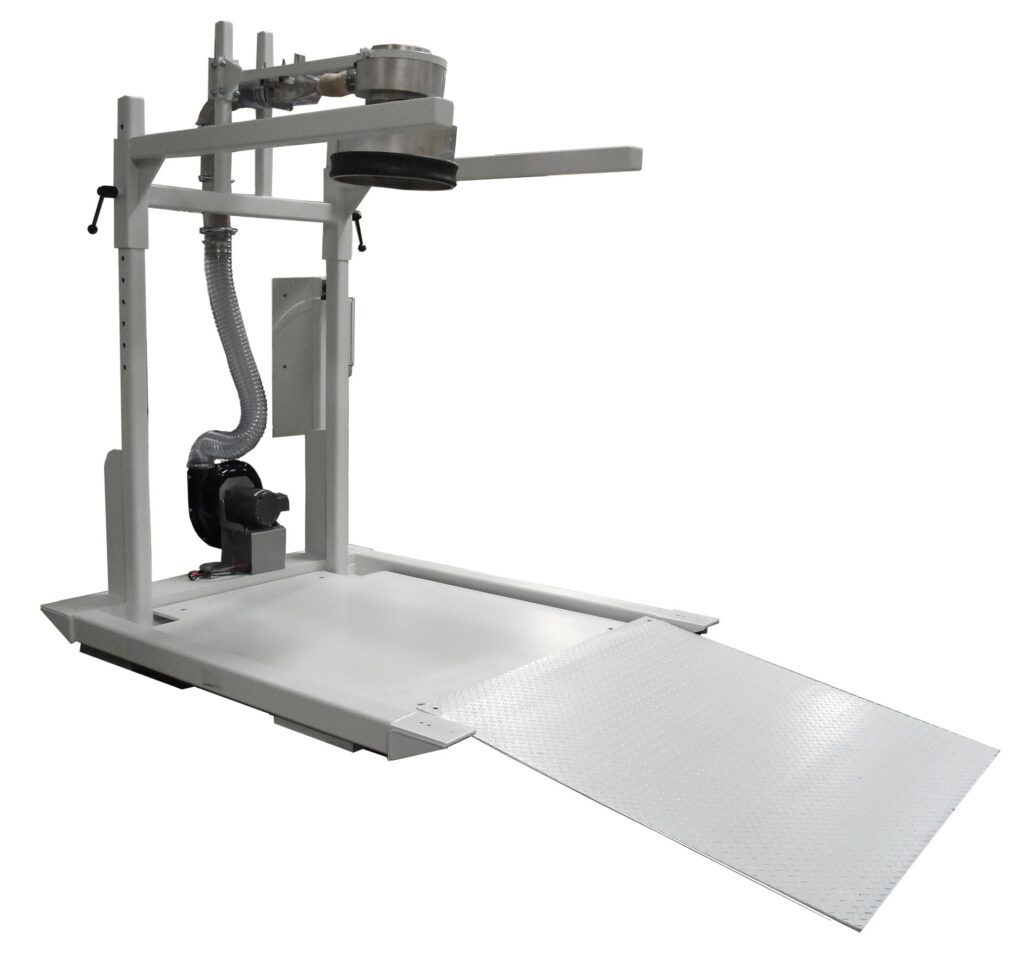
Pre-weighing Bulk Bags
The final step to increase the output of a single-station bulk bag filler is to reduce the time required to feed ingredients into the bag to meet a target weight. This can be done by pre-weighing the ingredients in a weigh hopper located directly above the filler. The “charge” of the ingredient is fed into the hopper to the target weight while the system or operator removes the previously filled bag and rigs the next.
Efficiency Gains With Pre-weighing and Automated Control Systems
Once the new bag is rigged, the pre-weighed charge is dropped into the bag quickly. As soon as the charge has left the pre-weigh hopper, the system begins to fill the next bag’s charge in the weigh hopper. In this configuration, the bulk bag filler itself does not perform weighing and, therefore, does not require a weighing system. However, the overall control system must be expanded to simultaneously perform weighing in the pre-weigh hopper while controlling the other functions associated with densification, automatic bag removal, and pallet and slip sheet dispensing. Pre-weighing, in association with automated controls and automatic bag removal, can increase the output of a single bulk bag filling station to 20 bags per hour.
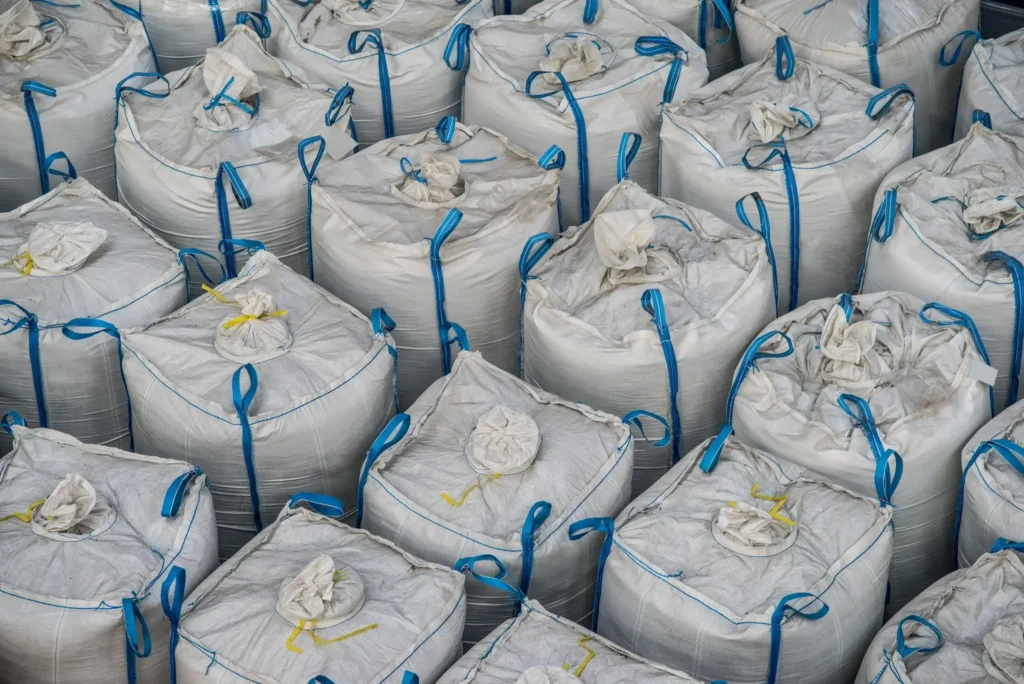
Multiple Bulk Bag Fillers Increase Bulk Bagging Rate
For production rates greater than 20 bags per hour, multiple bulk bag fillers can be used. The capital cost versus production rate must be assessed to arrive at the most effective total system configuration. For example, if 30 bags per hour are required, two automatic bag removal systems would be most appropriate. If 40 bags per hour are required, two pre-weighed, automatic bag removal systems would be selected.
More machines can be added and sequenced to further increase bag output. If more than 50 bags per hour are required, a decision must be made based on available space, operator availability, associated labor costs, and capital costs. A high-capacity system may be justified in this case.
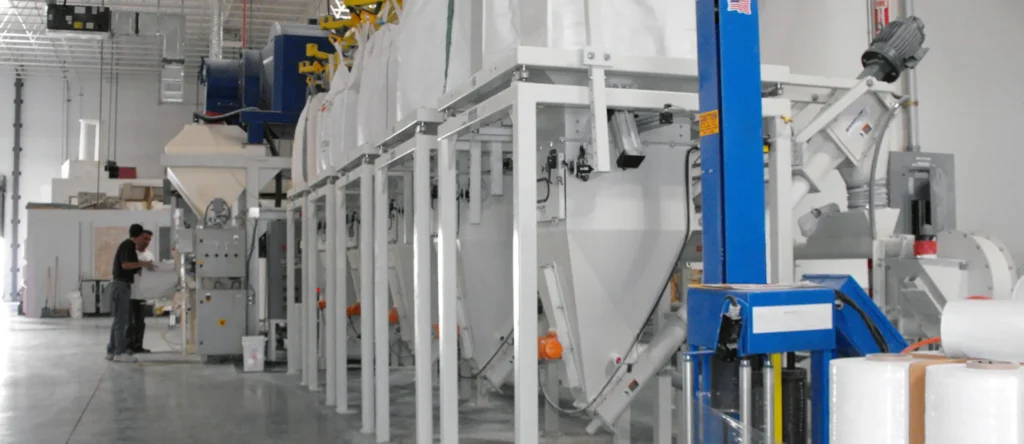
High-Capacity Bulk Bag Filler
For output greater than 50 bags per hour, a sophisticated multi-station, automated bulk bag-filling system is required. Such a system allows simultaneous rigging, filling, and bag removal. At 60 bags per hour and higher, a system of this complexity will be the most space, labor, and capital-cost-efficient alternative. Seventy one-ton bags per hour can be filled by only two operators. This permits just-in-time production and other associated cost benefits, including optimization of warehousing space.
Maximizing Output With Carousel Filling Stations and Multiple Units
If more than six bulk bags per hour need to be filled, it is worth considering automation possibilities. A single bulk bag filler’s output can be enhanced by filling-specific controls, pre-weighing, and integrating conveyor belt solutions and pallet and slip sheet dispensers. Furthermore, increases in output can be achieved by applying multiple units as long as the sequencing of the operator functions is carefully reviewed.
The ultimate in automation is provided by a carousel filling station, which can fill as many as 70 one-ton bags per hour. The effectiveness of any of these choices is predicated on the soundness of the design principles incorporated in the bulk bag filler.
Partner With Spiroflow for Advanced Bulk Bag Filler Solutions
The journey toward optimizing your bulk bag-filling operations hinges on choosing the right conveyor systems manufacturers and experts. Spiroflow, as a global leader in powder handling and dry solids processing with industrial conveyor systems, offers advanced filling and conveyor solutions that cater to your specific needs. With our emerging leadership in control systems integration, Spiroflow is equipped to enhance the efficiency and productivity of your processes.
Whether you’re aiming to increase output through carousel filling stations or seeking to integrate sophisticated automation in your bulk bag-filling operations, Spiroflow has the expertise and technology to make it happen. Don’t miss the opportunity to transform your bulk bag-filling process. Contact Spiroflow today and take the first step towards operational excellence.
Read how one Spiroflow customer utilized automated bulk bag filling to increase production: Case Study

